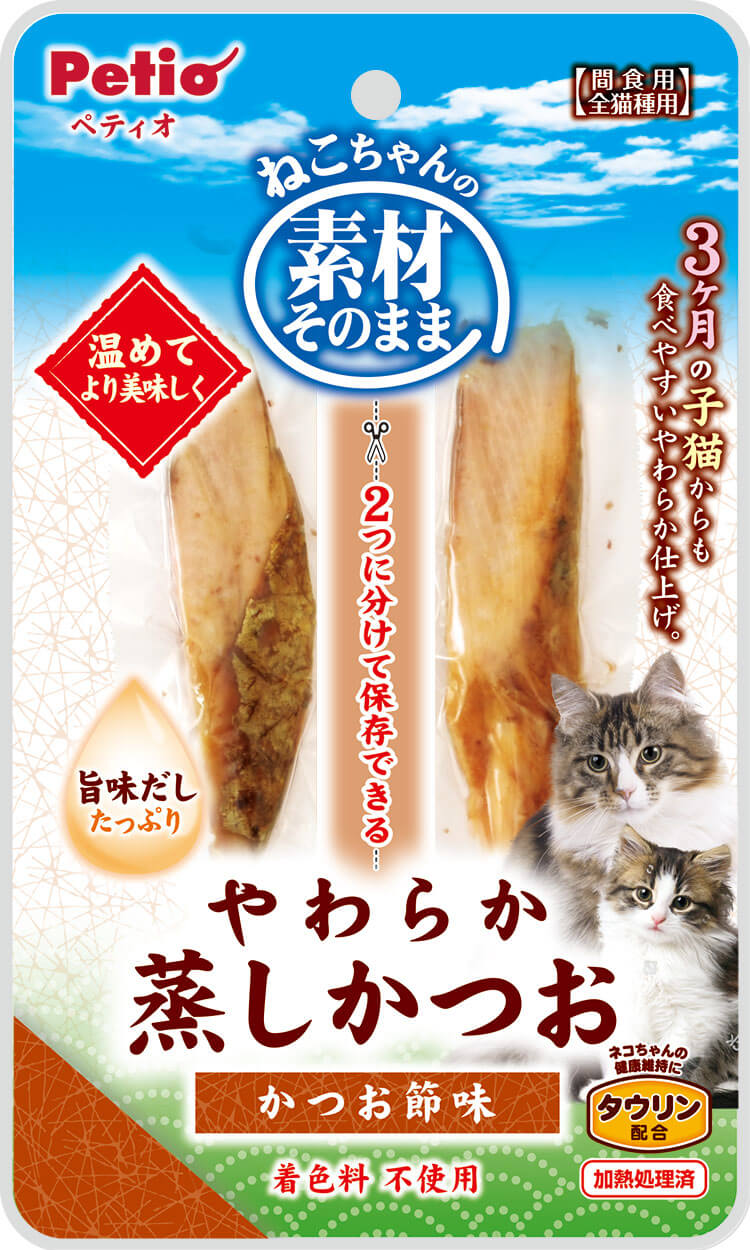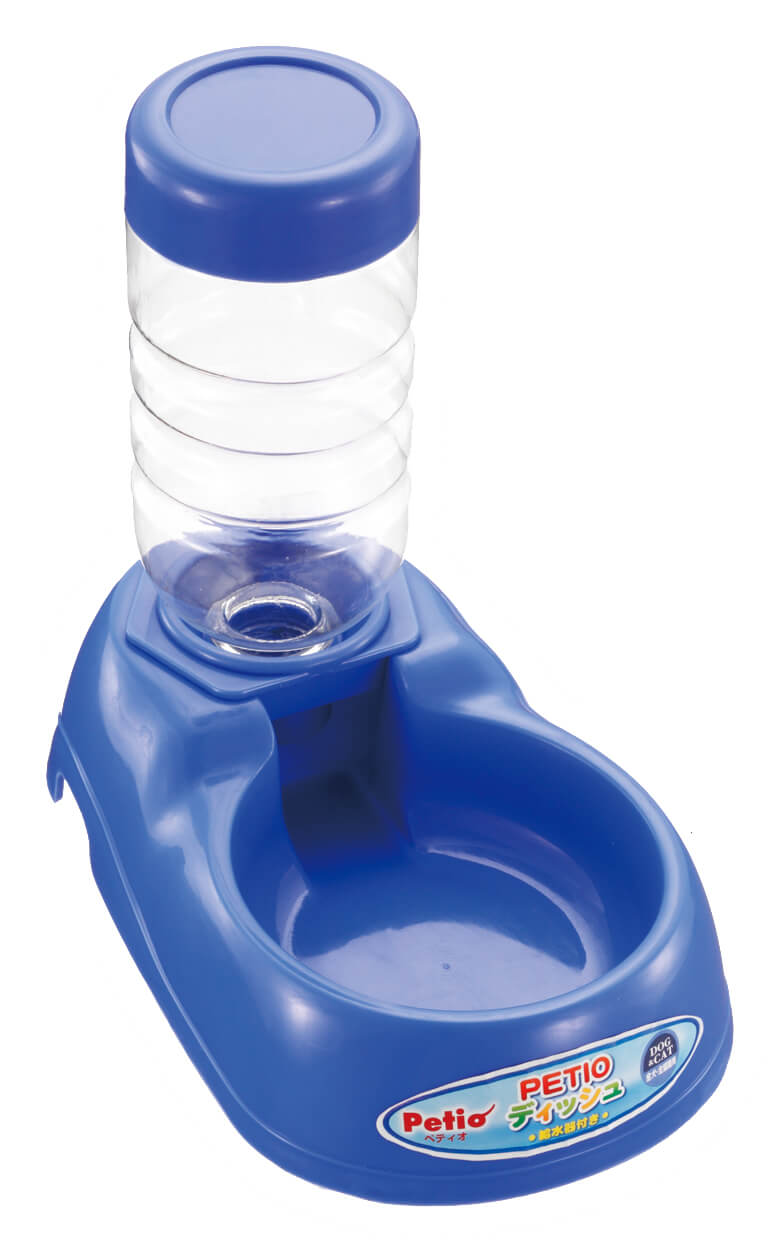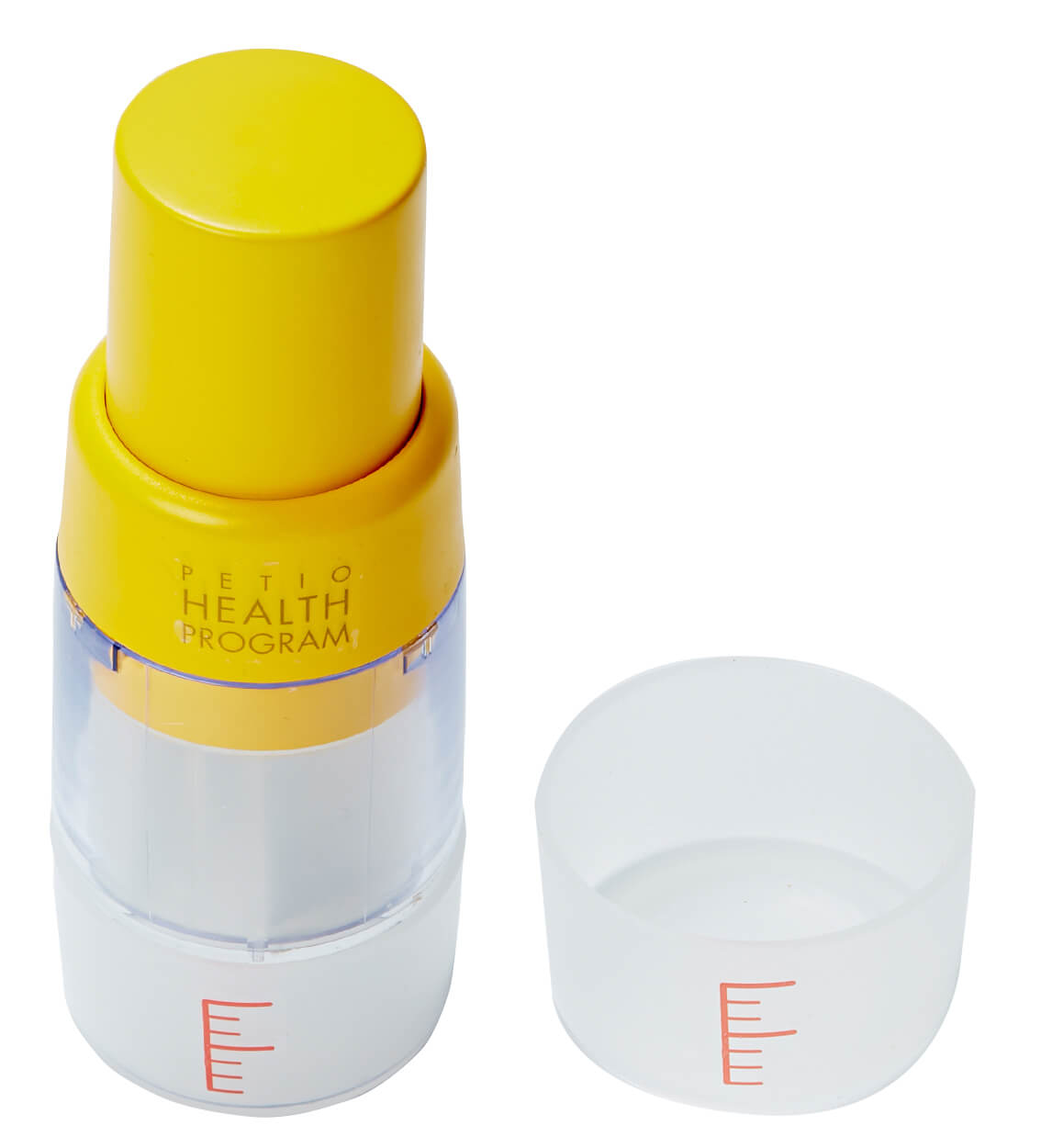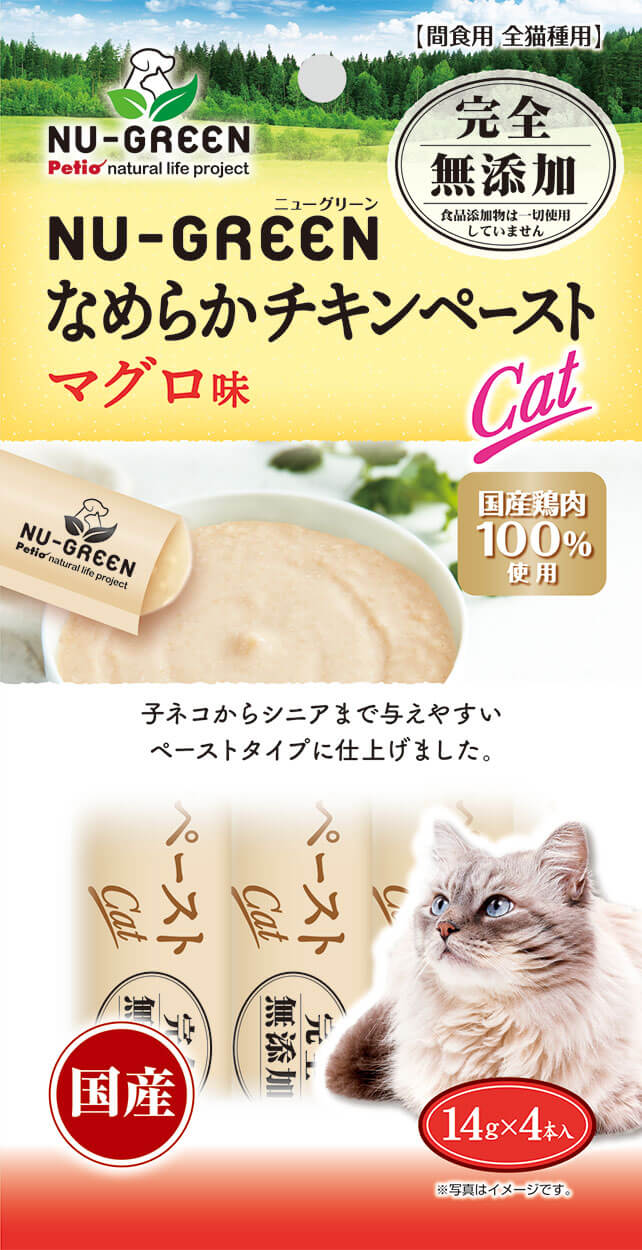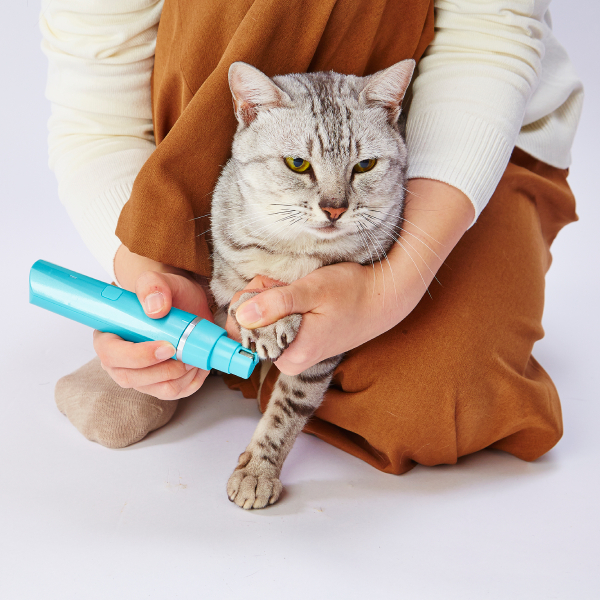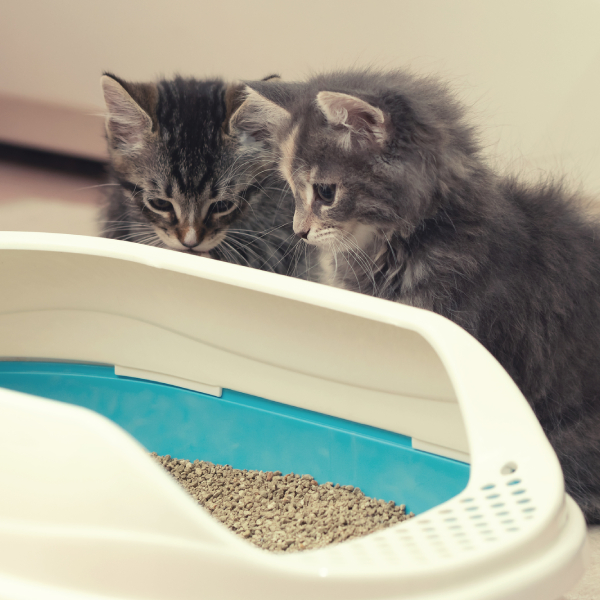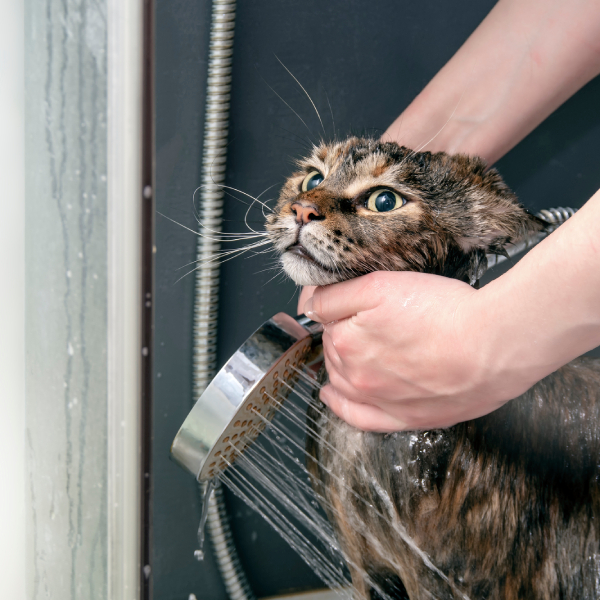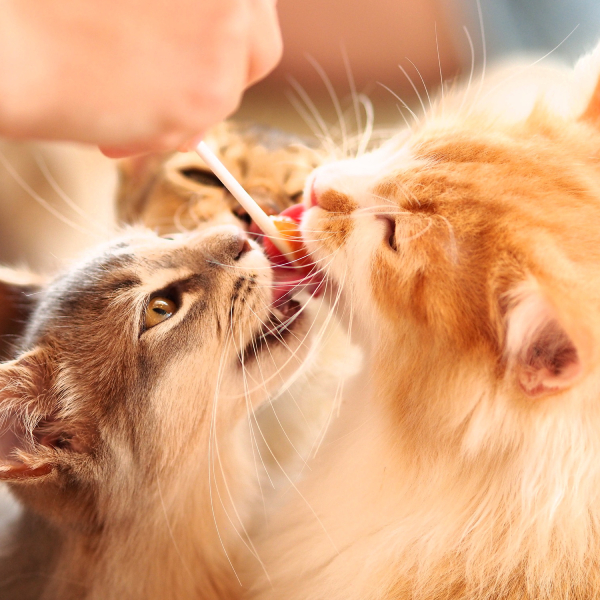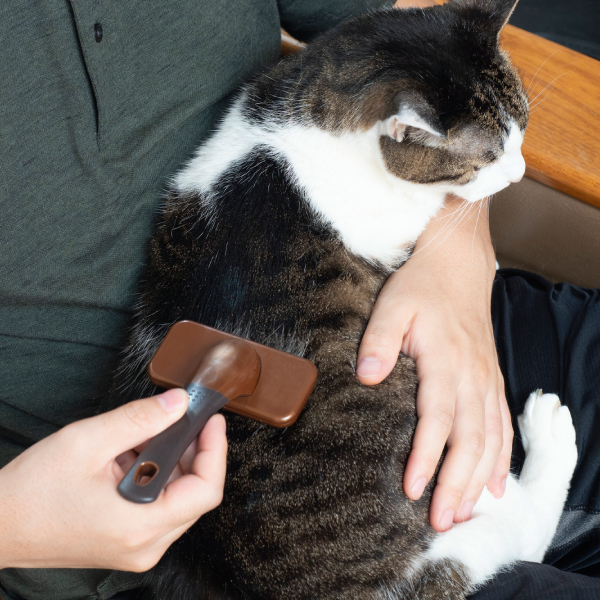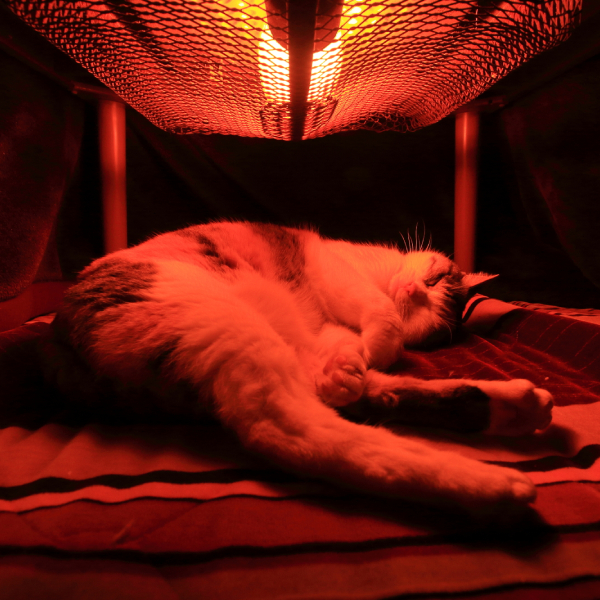特集/Pickup

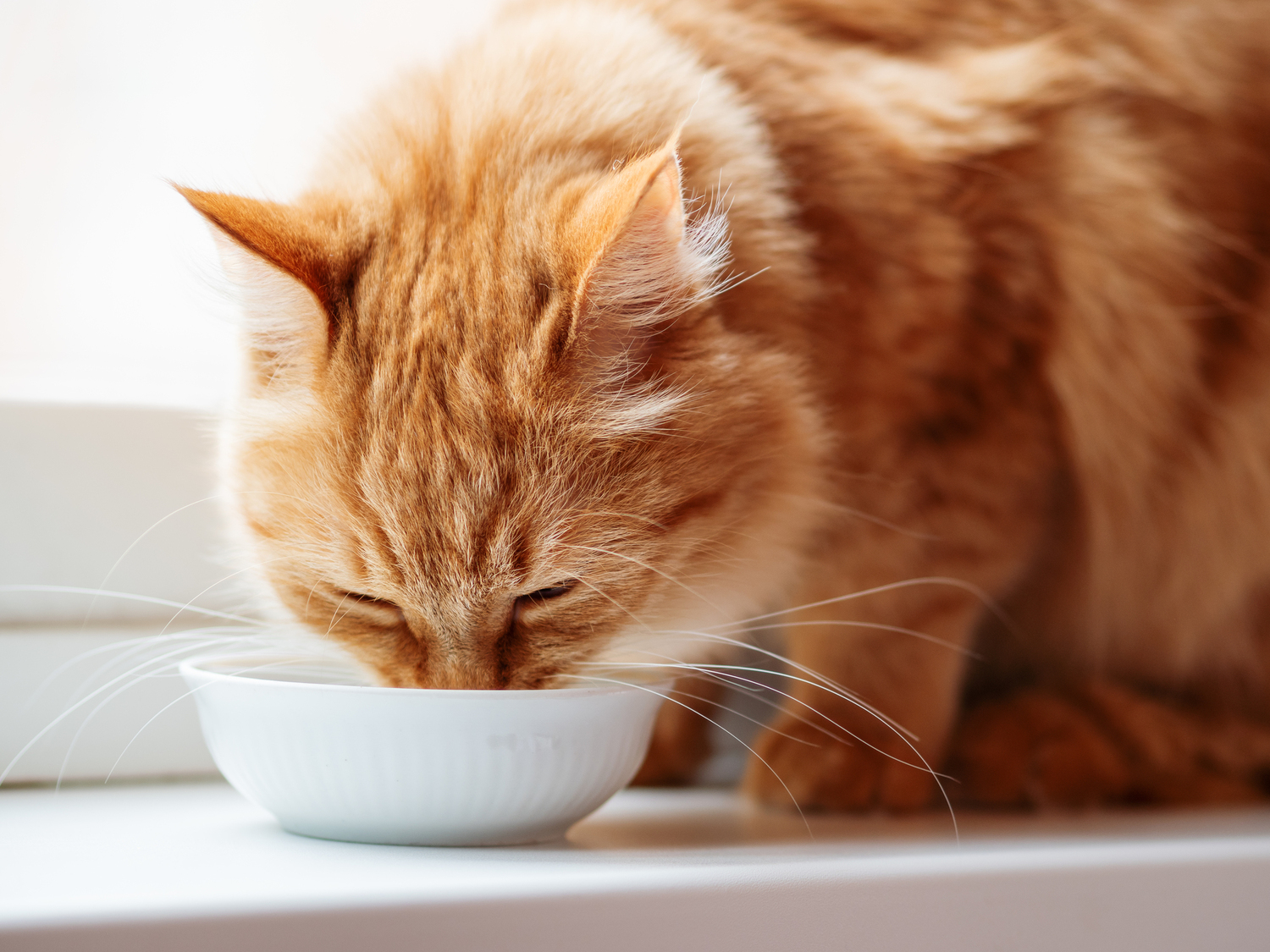
体が最も大きくなり、臓器も成長する大切な時期だからこそ、将来のことを考えて、子猫のうちのごはんは重要です。そこで、栄養バランスのとれたおいしいごはんの選び方や、ごはんの与え方のポイントについて解説します。(最終更新日2024年2月16日)

監修
静岡県島田市向谷3-918-9
TEL 0547-33-6010
北里大学獣医学部獣医学科卒業。専門学校ルネサンス・ペット・アカデミー非常勤講師、日本ペットマッサージ協会とペット薬膳国際協会の講師を務める。東日本大震災における被災動物レスキュー活動などにも参加。一般的な西洋医療のほか、鍼灸治療や漢方、ペットマッサージなどを通して動物の健康に取り組む。
1子猫の成長時期は大きく分けて3つある
子猫は、およそ1年間で成猫になります。著しく成長するこの時期は、体の変化もとても大きいものです。子猫の成長期間を大きく分けると、生後4週間までの「授乳期」、生後4~8週間の「離乳期」、生後8週間以降の「成長期」の3つに分けることができます。
子猫を飼う際には、それぞれの成長時期に適した食事方法や注意点を知っておくことが大切です。
2子猫に適したごはんと与え方のポイント【授乳期編】
授乳期の子猫に適したごはんは、どのような物なのでしょうか。与え方のポイントとともにご説明します。
授乳期の子猫へのごはんは、母乳もしくは子猫用ミルクのみ
生まれてすぐから4週間頃までの授乳期の子猫は、お母さん猫の母乳か子猫用ミルクだけで育てます。この時期の子猫はまだ体が十分に出来上がっていないため、ごはんもミルクしかまだ消化することができません。
お母さんの猫の母乳は高脂肪・高たんぱくで栄養がたっぷりです。特に、産後すぐの初乳には、生まれたばかりの子猫が細菌やウイルスなどから身を守るための、免疫を得るために重要な「移行抗体」が含まれています。そのため、できるだけお母さん猫がいっしょの場合は、母乳を与えるのがベストです。
ただ、お母さん猫の体調が優れなくて母乳を与えられない、もしくは生後早い時期の子猫を保護したり譲り受けたりした場合は、子猫用ミルクを与えて育てます。
子猫用のミルクは母乳と同じような成分になるよう、高脂肪・高たんぱくで乳糖も調整されているため、子猫のおなかを壊す心配もありません。1回に与える量や濃さが調整しやすい、粉ミルクタイプが日常的には使いやすいでしょう。また、若干割高ではありますが、液体ミルクもありますので、災害時や忙しいときのために常備しておいてもいいかもしれません。
子猫用ミルクの作り方
子猫用のミルクを与えるときは、作る前に手をきれいに洗い、清潔な子猫用の哺乳瓶に子猫の週齢に合わせた分量のミルクを入れ、一度沸騰させて60~70℃くらいまで冷ましたお湯で溶かします。これは、熱湯だとミルクの栄養分が壊れてしまい、温度が低すぎると脂肪分が溶けにくくなってしまうためです。ミルクが完全に溶けたら、人肌より若干温かいくらいまで冷ましてから子猫に与えます。
母乳や子猫用ミルクの与え方
子猫にミルクを与える際は、うつ伏せの姿勢にさせ、頭を少し上向きにさせます。人間の赤ちゃんのように仰向けの姿勢にすると、母乳やミルクが気管に入ってしまう可能性があります。哺乳瓶を斜め上から子猫の口に入れて45°くらいの角度を保ち、子猫のペースに合わせて飲ませてあげましょう。
哺乳瓶を押してしまうとミルクが一気に入り込んで、口からあふれたりむせて気管に入ってしまったりするので注意が必要です。母乳やミルクを飲みきってしまうか満腹になると、子猫は自分で哺乳瓶から口を離します。その後は、排尿・排便のお世話をしてあげてください。
母乳や子猫用ミルクを与える回数
猫が生後間もないうちは、ごく少ない量の母乳やミルクを頻繁に与えてください。子猫が成長するにつれ、一度に飲める量が増えていき、ミルクを与える回数は1日8回程度となります。頻度としては、2~4時間おきに1回くらいになっていきます。たとえ夜間であっても、母乳やミルクを与える間が空きすぎないようにしてください。
必要な母乳やミルクの量は子猫の週齢や体重などによって変わりますが、ミルクについてはそれぞれの製品に定められた体重あたりの参考量を目安にします。栄養はできるだけ多く摂取できたほうがいいため、子猫が欲しがるのであれば、飲めるだけ与えても構いません。あくまでも個体差があるため、子猫の成長度合いや様子を見て細かく調整していきましょう。
3子猫に適したごはんと与え方のポイント【離乳期編】
授乳期を終えたら、次は離乳期です。乳歯が生えてくる生後4週間頃から、子猫は次第にミルク以外の食べ物にも興味を持ち始めます。ここでは、離乳食とお水について、与え方のポイントとともに説明します。
離乳食の選び方
母乳やミルクだけで育ってきた子猫にとって、食べることは初めての経験となります。そのため、離乳期に与えるごはんは、飲み込みやすくやわらかい物を用意することがポイントです。子猫専用のウェットフードは離乳期の子猫にとって食べやすいごはんであるため、とても便利でしょう。もしくは、子猫用のドライフードをお湯でふやかして、やわらかくした物でもOKです。
今まで飲んでいたミルクを混ぜてあげると、飲み慣れたにおいや味に似るため、子猫が食べやすくなります。そして徐々にふやかす量を減らしていって幼猫用フードに移行していきます。
離乳食の与え方
与える離乳食は人肌くらいかややぬるいくらいの温度で、最初は小さじ1杯程度の量から始めましょう。いつものミルクのタイミングで、離乳食を浅めの小さいお皿にのせて与えてみます。子猫が興味を持って舌で少し食べられたら成功です。もし、食べなかったり興味を持たなかったりしても心配はありません。この時期は、あくまでごはんに慣れさせるのが目的ですので、気長に与えてみてください。
まだフードだけでは十分に栄養はとれないため、離乳食の後にはミルクを飲ませます。もし顔の周りに離乳食の汚れがついているようならば、きれいに拭き取ってあげましょう。
離乳食を与える回数
離乳期の子猫は、胃が小さく消化機能もまだ十分に発達してはいないため、一度の食事でたくさんの量を食べることはできません。週齢やその子の状態にもよりますが、1日のごはんの総量を4~8回くらいに分けて与えてください。
子猫が食べることに慣れてきたら、徐々に母乳やミルクの回数を減らして離乳食の量を増やしていきます。この際、毎日体重を測っておくと、適正な量を食べられているかの目安になります。
この頃には、ごはんの回数も1日6回程、間隔も3~6時間程度になってくるでしょう。ほとんどの場合、夜中のミルクは必要なくなり、生後8週頃には母乳やミルクを卒業できるようになります。
子猫が離乳食を食べないときの対処法
初めてのごはんに少し怖がったり慎重になったりして、食べない子猫もいるかもしれません。そんなときは、指先や手のひらに離乳食をのせて差し出すなどして安心させ、子猫のペースに合わせて慣れさせていきましょう。
離乳食を与えた子猫がゆるめの便をしたときの対処法
離乳食を始めたばかりの頃にゆるめの便をするようであれば、離乳食の量を減らして母乳やミルクの量を増やす、少なめの離乳食を数回に分けて与えるなど調整してみてください。
それでもゆるいままの場合や、離乳食によって突然下痢をしたといった場合は、すぐに動物病院に相談してください。その際には、診断しやすいよう離乳食を用意するといいでしょう。
お水の与え方
離乳期は、離乳食を食べられるようになるとともに、お水を飲めるようにもなる時期です。
新鮮で清潔なお水をボウルに入れ、子猫がいつでも飲めるように用意しておきましょう。最初はなかなかお水を飲まない子もいます。ですが、子猫がよく行ったり来たりするお気に入りの場所にお水を置いたり、家の中の何ヵ所かに分けてお水を置いたり、お水を入れる器の大きさや形を変えるなどの工夫をしたりすると、次第に興味を持って飲んでくれるようになります。
与えるお水の注意点
子猫に与えるお水は、基本的に水道水でOKです。ここで注意すべきは、ミネラルウォーターです。ミネラルウォーターに含まれるマグネシウムやカルシウムといったミネラル分は、猫が摂取しすぎると尿路結石や膀胱結石の原因となりますので、含有成分には十分注意してください。子猫が安心して必要な水分量をとれるよう、与えるお水の量にも気をつけましょう。
また、猫はにおいに敏感な動物であるため、水道水の塩素臭や、食器についた中性洗剤のにおいを嫌がる猫もいます。お水の温度の好みも子猫によってさまざまです。その子猫に合ったお水の状態を保ってあげてください。
そして、猫はとにかくきれい好きです。お水は毎日変えて、容器もこまめに洗って清潔を保つことも重要です。
4子猫に適したごはんと与え方のポイント【成長期編】
離乳期を終えたら、次は成長期です。食べることやさまざまな味に慣れ出す8週齢頃からは、離乳食から本格的な子猫用フードへと移行していく時期になります。
成長期の子猫に与えるべきごはんについて、与え方のポイントとともにご説明しましょう。
与え方のポイント
成長期である8週齢頃には、固い物も食べられるようになっていきます。しかし、これまで母乳やミルク、離乳食などを主食としていた子猫は、それらより固いフードを急にうまくは食べられません。
そのため、歯応えがしっかりあるドライフードだけ与えるのではなく、水分が多くやわらかいウェットフードと交互に与えたり、ドライフードとウェットフードを混ぜてみたりと、無理なく与えるようにしましょう。焦らずにドライフードなどの硬いフードに移行していくことが望ましいです。
成長期のごはんは、子猫用の総合栄養食がおすすめ
成長期の子猫は動きもどんどん活発になり、体もグンと大きくなるため、体重の割に大きなエネルギー量を必要とします。体格や骨格が作られるこの時期に、栄養分をしっかり摂取するのは必要不可欠です。この頃に十分な栄養を与えられるか否かが、丈夫な体づくりや今後の健康維持を左右します。
そのため、この時期の猫には、子猫用の「総合栄養食」を与えるのがおすすめです。総合栄養食には、ビタミンやミネラル、たんぱく質、必須脂肪酸、炭水化物、繊維質など、子猫の成長に欠かすことのできない栄養素がバランス良く配合されています。
ビタミンは目や骨の成長に有効であり、ミネラルは代謝アップ、たんぱく質は体の筋肉などを作ってくれるなど、総合栄養食に含まれている栄養分は子猫のすこやかな成長をしっかりサポートしてくれるのです。
成長期のごはんの回数
ごはんの回数は、生後4ヵ月くらいまでは1日5、6回程度で、生後6ヵ月くらいまでには1日3、4回に減ります。また、体つきがしっかりしてくる6ヵ月頃からは、1日2、3回へと落ち着いていきます。
5子猫に与えてはいけない食材
子猫の健康維持のため、子猫に与えてはいけない食材も多くあります。最も注意が必要なのは、玉ねぎなどのネギ類や、イカ・エビなどの甲殻類、チョコレート、スパイス類などです。スパイス類は、魚肉ソーセージなどに入っている場合もあります。これらは下痢や嘔吐、中毒症状を引き起こすことがある危険な食材です。誤って食べてしまわないように十分な注意が必要です。
また、そもそも猫の消化機能は、人や犬と異なります。いろいろな食材をあげすぎると消化しきれず、下痢などを起こしてしまうこともあります。そのため、基本的に人間用の食べ物はあげないようにするのが望ましいです。特に味つけしてある物、塩分、糖分、脂質の高い物は、猫の体には良くありません。子猫が留守番中にいたずらして食べてしまうようであれば、人間の食べ物は見つけられないよう、しっかりとした保管が必要になります。
子猫には、極力普段のごはん以外はあげないほうが良いのですが、もし、トッピングで肉や魚などを足したいなど、猫用ごはん以外の新しい食材を与える場合は、あげてはいけない食材ではないことを確認し、味のついていない新鮮な物を少量あげるようにしてください。またかかりつけの獣医師から食餌に関して指示が出ている場合は、そちらを優先しましょう。
6子猫用ごはんのメリット・デメリット
市販の子猫用ごはんには、一般的に「カリカリ」と呼ばれるドライフードと、ウェットフードの2種類があります。それぞれの特徴や、メリット・デメリットを見ていきましょう。
ドライフードのメリット・デメリット
水分量が10%以下のドライフードのメリットは、その多くが栄養価の高い総合栄養食であるため、子猫の1日に必要な栄養素をバランス良くとれる点が挙げられます。また、水分含有量が少ないため開封してからも保存性が高く、比較的安価な物が多い点もメリットです。歯応えが良く、咀嚼することで歯の表面がこすれて歯石が落ち、歯肉も刺激されるため、口内炎の予防にもつながる点もドライフードならではのメリットです。
その反面、ドライフードはその固さゆえ、慣れるまで子猫にはそのまま食べさせられないというデメリットもあります。さらに、ドライフードは水分が少ないため、お水をきちんと飲む子でないと場合によっては水分不足を起こしてしまうことも。そのため、子猫の週齢が低いうちは、お湯でふやかしたりウェットフードと混ぜたりするなど、工夫して与えるといいでしょう。
ウェットフードのメリット・デメリット
水分量が10%よりも多いウェットフードには、缶詰タイプと少量ずつ袋に密閉保存されたパウチタイプの2種類があります。
ウェットフードは水分含有量が多いため、まだ歯が弱くドライフードに慣れない子猫でも食べやすい点はメリットです。また、高カロリー・高たんぱくである物が多いため、少ない量でもエネルギーをしっかりとれる点もウェットフードのメリットとして挙げられるでしょう。味のバリエーションも豊富で、フレークタイプ、パテタイプ、スープタイプなど、形状もさまざまであるため嗜好性が高く、子猫の食欲があまりないときでもよく食べてくれるというメリットもあります。
一方、ウェットフードは、一度開封してしまうとすぐに消費してしまわないと鮮度を保てない、歯に汚れがつきやすいため歯のケアをしっかりしてあげなければならないといったデメリットもあります。
7子猫用ごはんを選ぶ際のポイント
子猫用ごはんのメリット・デメリットを踏まえ、どのようなごはんを選んであげれば良いのでしょうか。ここでは、子猫用ごはんを選ぶ際の3つのポイントについてご説明します。

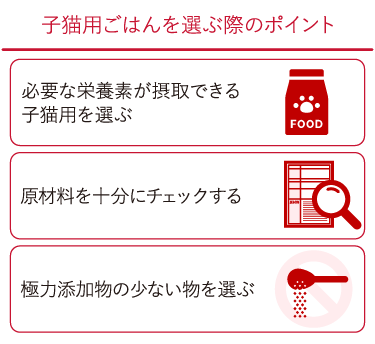
必要な栄養素が摂取できる子猫用を選ぶ
子猫のごはんは、子猫用を選びましょう。猫は、年齢によって必要な栄養素が異なります。そのため、「子猫用」「成猫用」「老猫用」など、その年齢や状態に合った製品に分かれているのです。
子猫は体を作る成長期にあたり、しっかりエネルギーを摂取する必要があります。ですから、子猫用のごはんは成猫用のごはんよりカロリーやたんぱく質が高めになっています。また、子猫用のごはんは、小さい子猫でも食べやすいよう、やわらかめで形も小さいです。
ちなみに、「全年齢用」というごはんもあります。このタイプのごはんは、多頭飼いでほかの猫たちもいる場合や、フードの切り替えが難しい状況のときにおすすめです。
原材料を十分にチェックする
子猫用ごはんは、原材料も大切です。キャットフードの原材料表示には、使用している成分をすべて記載することが義務づけられています。原材料表示は「記載順=含有量の多い順」となっているため、最初に記載されている原材料が、その商品に最も多く含まれている成分になります。何が使われているか、見慣れない材料が含まれていないか、アレルギーの元になりそうな物が入っていないかなどをチェックしてください。チキンなどの動物性たんぱく質が多ければ、高たんぱくで子猫の栄養には十分といった判断ができるはずです。また、穀物は猫にとっては消化に良くありません。穀物が入っている物は極力避けるようにしましょう。
それぞれの子猫の好みもありますが、子猫にとって必要な物が入っているか、避けたい素材が入っていないかをしっかりチェックすることが必要です。
極力添加物の少ない物を選ぶ
原材料とともに大切なのは、添加物のチェックです。猫のごはんは、着色料や保存料が入っている物がほとんどです。ある程度は仕方ないこととはいえ、繊細でさまざまな物に敏感な子猫の体には、影響がまったくないとはいえません。
気にしすぎることはないかもしれませんが、できれば添加物が多く使用されている物は避けたいところです。無添加の物がもし売っている場合は、極力そちらを選ぶといいでしょう。
ペティオおすすめの子猫用アイテム
-
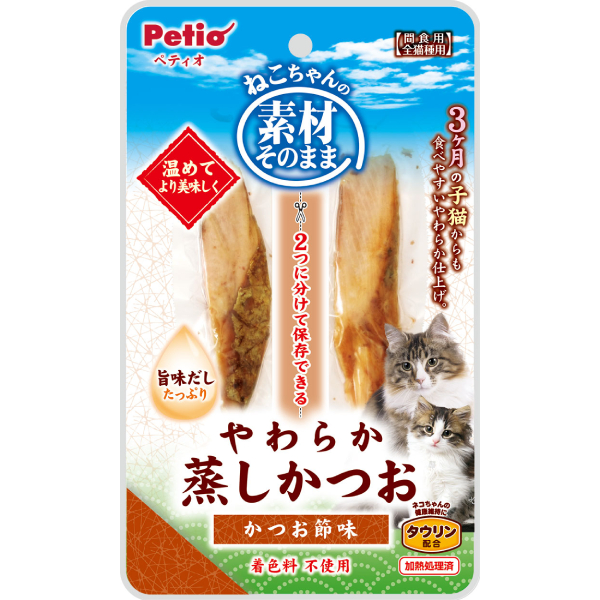 素材そのまま ねこちゃんの やわらか蒸しかつお かつお節味 2本入生後3ヶ月の子猫から食べられるやわらか蒸しかつお。良質なかつをを柔らかく蒸しておいしさをギュッと閉じ込めました。そのままおやつとしてはもちろん、ほぐしてフードのトッピングにもオススメ。2つに分けて保存できるからいつでも開けたてをあげられる!ネコちゃんの健康維持にタウリン配合。着色料無添加。
素材そのまま ねこちゃんの やわらか蒸しかつお かつお節味 2本入生後3ヶ月の子猫から食べられるやわらか蒸しかつお。良質なかつをを柔らかく蒸しておいしさをギュッと閉じ込めました。そのままおやつとしてはもちろん、ほぐしてフードのトッピングにもオススメ。2つに分けて保存できるからいつでも開けたてをあげられる!ネコちゃんの健康維持にタウリン配合。着色料無添加。 -
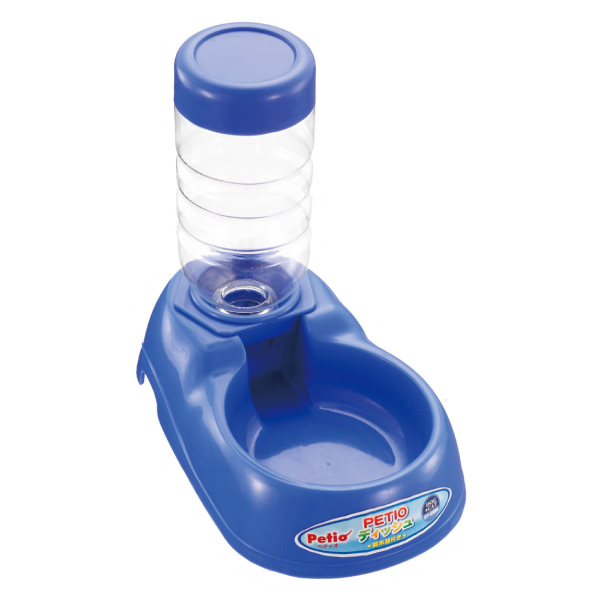 PETIOディッシュ 給水器付き ブルーいつでも新鮮な水が飲める給水器。水が少なくなると自動的に給水されるから、うちの子が飲みたいタイミングで新鮮な水が飲める!
PETIOディッシュ 給水器付き ブルーいつでも新鮮な水が飲める給水器。水が少なくなると自動的に給水されるから、うちの子が飲みたいタイミングで新鮮な水が飲める! -
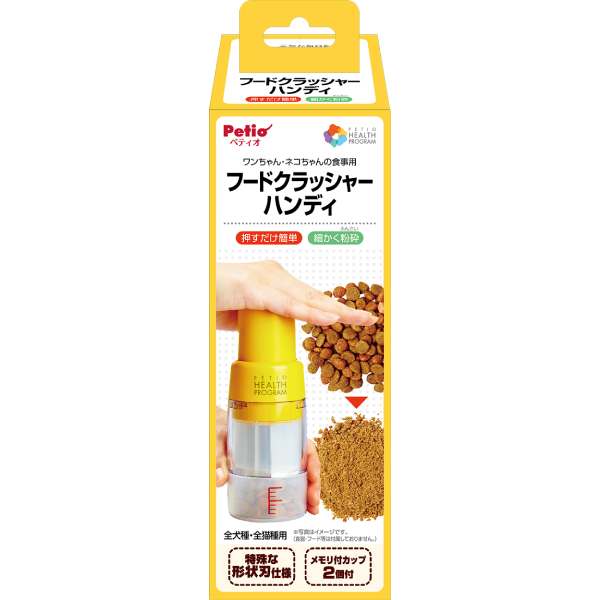 ヘルス プログラム フードクラッシャー ハンディ押すだけで簡単にフードやおやつ、薬などを細かくできるアイテム。いつものごはんを食べやすくしてあげるだけでなく、トッピングを作ったり手作りごはんにもオススメ。押す回数で細かさの調整が可能だから、うちの子に合わせてお使いいただけます。
ヘルス プログラム フードクラッシャー ハンディ押すだけで簡単にフードやおやつ、薬などを細かくできるアイテム。いつものごはんを食べやすくしてあげるだけでなく、トッピングを作ったり手作りごはんにもオススメ。押す回数で細かさの調整が可能だから、うちの子に合わせてお使いいただけます。
8子猫の頃にごはんをしっかり食べさせることが、丈夫な体づくりにつながる
丈夫な体を作るため、子猫のごはんは大切です。とはいえ、まだまだ食べる力も弱く、胃も小さい子猫に順調にごはんを食べさせるのは、最初のうちは大変かもしれません。
子猫がごはんを楽しんで食べられるよう、工夫してゆっくり気長に与えていきましょう。
9
よくある質問
子猫のえさQ&A
- 子猫のご飯の与え方のポイントは?
-
生まれてすぐから4週間頃までの授乳期の子猫は、お母さん猫の母乳か子猫用ミルクだけで育てます。乳歯が生えてくる生後4週間頃から、離乳期に与えるごはんは、飲み込みやすくやわらかい離乳食、そして徐々に幼猫用フードに移行していきます。成長期である8週齢頃には、子猫用の「総合栄養食」を与えるのがおすすめです。
- 子猫に与えてはいけない食材とは?
-
子猫に与えてはいけない食材は、玉ねぎなどのネギ類や、イカ・エビなどの甲殻類、チョコレート、スパイス類などです。スパイス類は、魚肉ソーセージなどに入っている場合もあります。これらは下痢や嘔吐、中毒症状を引き起こすことがある危険な食材です。誤って食べてしまわないように十分な注意が必要です。
- 子猫用ごはんを選ぶ際のポイントは?
-
必要な栄養素が摂取できる子猫用のごはんを選ぶようにしましょう。子猫用のごはんは成猫用のごはんよりカロリーやたんぱく質が高めになっています。体を作る成長期にあたり、しっかりエネルギーを摂取できるご飯を選びましょう。その他にも何が使われているか、見慣れない材料が含まれていないか、アレルギーの元になりそうな物が入っていないかなどを原材料もチェックするようにしましょう。

